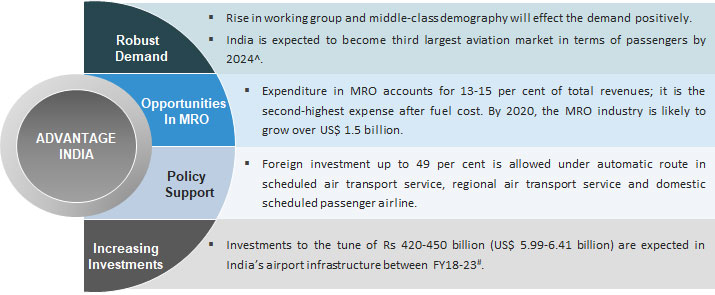Indian Economy
Reforms In Civil Aviation Industry
- 04 Jun 2020
- 7 min read
This article is based on “Aviation reforms: good enough to fly high?” which was published on The Hindu Business line on 02/06/2020. It talks about the challenges and steps to be taken for the civil aviation industry.
Covid-19 pandemic has brought global economic activity to a standstill and its effects on the Civil Aviation sector is no different. This can be testified from the fact that the world’s second-oldest airline (Avianca) has already filed for bankruptcy.
Travel and aviation sectors contribute significantly to the GDP of most countries and thus, it is critical to ensure economic growth and development. Recognising its importance many governments in the world have already announced significant financial packages for their respective aviation industry.
In this pursuit, the Government of India has also announced civil aviation reforms under Atma-Nirbhar Bharat Abhiyan. However, for a thriving civil aviation industry, there is a need to address the systemic challenges.
Reforms Under Atma-Nirbhar Bharat Abhiyan
Efficient Airspace Management
- Route dispersal guidelines (RDG), mandates airlines to fly a certain percentage of flights in smaller, unprofitable air routes. The government announced that these restrictions on the utilisation of Indian airspace will be eased.
- This will lead to optimal utilization of airspace and reduction in fuel use.
Airports Development through PPP
- In addition to the existing ones (e.g. Airports at Delhi, Mumbai, Hyderabad), six more airports will be auctioned under the Public-Private-Partnership (PPP) model for their development.
Global Hub for Aircraft Maintenance, Repair and Overhaul
- The government intends to make India a global hub for Aircraft Maintenance, Repair and Overhaul (MRO) services.
- Also, the convergence between the Defence sector and the civil MROs will be established to bring down the maintenance cost of airlines.
Systemic Challenges
Infrastructure Deficit
- Inadequate hangar space and unavailability of land to expand airports at their current sites, particularly in major cities, are two of the major constraints that face the sector.
- Also, the development of more airports under the PPP model with a view to improving the aviation infrastructure without the government having to pump in additional funds is also a roadblock.
- Airport infrastructure development is a challenging process often marred with completion delays on various fronts including time taken to procure governmental approvals.
High Fuel Cost
- Fuel cost as a percentage of operating charges amounts to 45% in India as compared to the global average of 30 per cent.
- The prices of aviation fuel in India are approximately 60% higher than prices in ASEAN and the Middle East countries because of high central and state taxes.
- This makes the profitability of the civil aviation industry vulnerable to volatility in global oil prices.
Skill Deficit
- Shortage and gaps in the availability of industry-recognised skills – from airline pilots and crew to maintenance and ground handling personnel – constrains the growth of different segments of the sector.
Way Forward
Enhance Aviation Infrastructure
- There is a need to complete the ongoing projects under the UDAN initiative in a time-bound manner. In addition, the existing capacity of international airports should be augmented under the International UDAN initiative.
- Government intention to make India a global hub for Aircraft Maintenance, Repair and Overhaul (MRO) services will result in saving costs and creating liquidity for airline companies.
- Also, convergence between civil MROs and the defence sector should create economies of scale and long-term benefits.
- Formulation of long-term plans for advanced research in aviation technologies will help in creating a manufacturing ecosystem in the country
Address Shortage of Skilled Manpower
- There is a need for promotion of collaboration between original equipment manufacturers (OEMs), industry and educational institutes to assimilate the latest technology and management practices in the aviation industry.
Augmenting Finances
- Taxation and pricing structure of aviation turbine fuel (ATF) should be aligned to global benchmarks by considering bringing under the ambit of GST.
- Vacant real estate near Airports Authority of India (AAI) airports in all major centres can be monetised to increase non-aeronautical revenues.
Making India a Transhipment Hub
- India can reap multiple benefits by establishing itself as a transhipment hub in the region. This will augment India’s trading capacity as a service provider, emerging as a foreign exchange earner and enabler for better connectivity in the region.
- This may be done by the development of digital business enablers such as e-contracting, e-transportation multimodality, e-compliances and an e-grievance redressal module.
In this context, the National Civil Aviation Policy 2016 and National Civil Aviation programme 2018 can help India to become a major civil aviation market in the world.
|
Drishti Mains Answer Analyse the challenges faced by India’s civil aviation industry. Also, discuss the measures to reap the huge potential of this industry in India’s growth story. |
This editorial is based on “After Amphan, Nisarga sounds a warning bell” which was published in The Hindustan Times on June 3rd, 2020. Now watch this on our Youtube channel.







